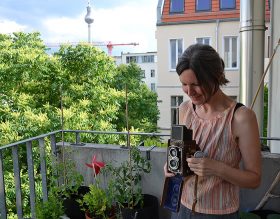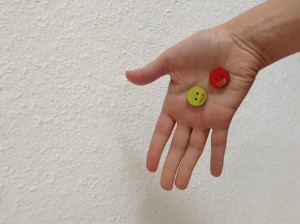A Visit to the Photographer and Architect Birgit Glatzel

Birgit Glatzel with her Rolleiflex camera; Jewish Museum Berlin, photo: Mariette Franz
It’s a warm summer’s day when I visit Birgit Glatzel in Prenzlauer Berg, the same kind of day it must have been when she shot her photograph “Angela and Me,” which, like her short film “Going to Jerusalem,” has been available in our art vending machine since April (more information on our website).
“Angela and Me” is part of a series in which the artist portrays herself with a friend in self-timed pictures. All the photographs are taken with a 1937 Rolleiflex camera, and the location and backdrop are always chosen together with the friend in question. Birgit embarked upon the project shortly before her emigration to Israel in 2007 – she wanted to take photos to remember her friends in Germany. “Memories play an important role in Judaism, for example an original piece is always left in a newly refurbished apartment,” explained the artist, who trained as an architect and works as such to earn her living. → continue reading
An Interview with Lina Khesina
30 July 2014 is International Friendship Day. But how do we commemorate friendship? Or how do we make it visible? We consulted with communications designer Lina Khesina to find out. She devised a pair of ‘friendship buttons’ that you can get at the moment from the art vending machine in our permanent exhibition. One of them features the word “Tsemed” in Hebrew script, and the other one the word “Chemed.”

The buttons “Tsemed” and “Chemed”.
Photo courtesy of the artist
Lisa Albrecht: Lina, why did you develop this item in particular for the art vending machine?
I had the idea of showing the beauty of the Hebrew language and transmitting it in an everyday way. I don’t actually speak Hebrew myself, but purely from a musical perspective I find it and Spanish the two most beautiful languages. So I really wanted to discover Hebrew for myself and find a constellation of words in the language that I could play with. That’s how these buttons with the wordplay emerged.
How did the wordplay occur to you?
In Russian, best friends are often called “nje rasléj wodá”, which more or less means “even water cannot destroy this bond.” I did some research on whether there’s such an idiom in Hebrew as well and thus learned about “Tsemed Chemed.” Translated literally, it means “sweet entanglement” or “fine pair”, and is an expression for ‘close friends.’
What do these two words have to do with the buttons?
Buttons get sewed on with a thread and become then ‘entangled,’ or interwoven, with the material. Close friends experience something similar, even when they live thousands of kilometers apart. Like the buttons, they’re connected to each other by the thread and the adage. → continue reading
Inés Garland’s Novel for Young Adults about Friendship and Love
During the week of October 21 to 27, 2013 the Academy of the Jewish Museum Berlin, in cooperation with Kulturkind e.V., will host readings, workshops, and an open day for the public with the theme “Multifaceted: a book week on diversity in children’s and young adult literature.” Employees of various departments have been vigorously reading, discussing, and preparing a selection of books for the occasion. Some of these books will be introduced here over the course of the next few months.

Why are young adult novels touching in a different way than books for adults? And why are they touching not only for young people?
Is it that the writers of stories for young adults are less embarrassed to use everything they have to elicit strong feelings in their readers?
Barring Harry Potter, I hadn’t read any young adult books since my own adolescence, until reacquiring a taste for them over the course of our reading marathon. A taste for giving myself over completely to the beautiful, tragic, comic destinies of the characters, for succumbing to a story. For example, to the story of Alma in Inés Garland’s book Piedra, papel o tijera [‘Rock, Paper or Scissors’] (in the original Spanish, or Wie ein unsichtbares Band [‘Like an Invisible Ribbon’] in the German edition): → continue reading


